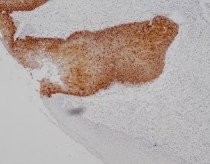ARG67062
anti-p16 antibody [SQab30345]
anti-p16 antibody [SQab30345] for IHC-Formalin-fixed paraffin-embedded sections,Western blot and Human

1
Overview
| Product Description | Recombinant Mouse Monoclonal antibody [SQab30345] recognizes p16 |
|---|---|
| Tested Reactivity | Hu |
| Tested Application | IHC-P, WB |
| Host | Mouse |
| Clonality | Monoclonal |
| Clone | SQab30345 |
| Isotype | IgG |
| Target Name | p16 |
| Antigen Species | Human |
| Immunogen | Recombinant protein fragment of p16 |
| Conjugation | Un-conjugated |
| Protein Full Name | p16 |
| Alternate Names | CDKN2A; Cyclin Dependent Kinase Inhibitor 2A; P14ARF; CDK4I; MTS1; ARF; P16-INK4A; CDKN2; CMM2; INK4; P16; P19; P14; MLM; Cyclin-Dependent Kinase Inhibitor 2A (Melanoma, P16, Inhibits CDK4); Cyclin-Dependent Kinase 4 Inhibitor A; Cyclin-Dependent Kinase Inhibitor 2A; Multiple Tumor Suppressor 1; Alternative Reading Frame; P16INK4a; P16INK4A; P19Arf; INK4a; MTS-1; Cell Cycle Negative Regulator Beta; CDK4 Inhibitor P16-INK4; Tumor Suppressor ARF; P16-INK4a; P16-INK4; P16INK4; P19ARF; INK4A; TP16 |
Application Instructions
| Application Suggestion |
|
||||||
|---|---|---|---|---|---|---|---|
| Application Note | * The dilutions indicate recommended starting dilutions and the optimal dilutions or concentrations should be determined by the scientist. | ||||||
| Observed Size | 16-18 kDa |
Properties
| Form | Liquid |
|---|---|
| Purification | Purification with Protein A. |
| Buffer | PBS, 0.01% Sodium azide, 40% Glycerol and 0.05% BSA. |
| Preservative | 0.01% Sodium azide |
| Stabilizer | 40% Glycerol and 0.05% BSA |
| Storage Instruction | For continuous use, store undiluted antibody at 2-8°C for up to a week. For long-term storage, aliquot and store at -20°C. Storage in frost free freezers is not recommended. Avoid repeated freeze/thaw cycles. Suggest spin the vial prior to opening. The antibody solution should be gently mixed before use. |
| Note | For laboratory research only, not for drug, diagnostic or other use. |
Bioinformation
| Database Links |
Swiss-port # P42771 Human Cyclin-dependent kinase inhibitor 2A |
|---|---|
| Gene Symbol | CDKN2A |
| Gene Full Name | cyclin-dependent kinase inhibitor 2A |
| Background | This gene generates several transcript variants which differ in their first exons. At least three alternatively spliced variants encoding distinct proteins have been reported, two of which encode structurally related isoforms known to function as inhibitors of CDK4 kinase. The remaining transcript includes an alternate first exon located 20 Kb upstream of the remainder of the gene; this transcript contains an alternate open reading frame (ARF) that specifies a protein which is structurally unrelated to the products of the other variants. This ARF product functions as a stabilizer of the tumor suppressor protein p53 as it can interact with, and sequester, the E3 ubiquitin-protein ligase MDM2, a protein responsible for the degradation of p53. In spite of the structural and functional differences, the CDK inhibitor isoforms and the ARF product encoded by this gene, through the regulatory roles of CDK4 and p53 in cell cycle G1 progression, share a common functionality in cell cycle G1 control. This gene is frequently mutated or deleted in a wide variety of tumors, and is known to be an important tumor suppressor gene. [provided by RefSeq, Sep 2012] |
| Function | Capable of inducing cell cycle arrest in G1 and G2 phases. Acts as a tumor suppressor. Binds to MDM2 and blocks its nucleocytoplasmic shuttling by sequestering it in the nucleolus. This inhibits the oncogenic action of MDM2 by blocking MDM2-induced degradation of p53 and enhancing p53-dependent transactivation and apoptosis. Also induces G2 arrest and apoptosis in a p53-independent manner by preventing the activation of cyclin B1/CDC2 complexes. Binds to BCL6 and down-regulates BCL6-induced transcriptional repression. Binds to E2F1 and MYC and blocks their transcriptional activator activity but has no effect on MYC transcriptional repression. Binds to TOP1/TOPOI and stimulates its activity. This complex binds to rRNA gene promoters and may play a role in rRNA transcription and/or maturation. Interacts with NPM1/B23 and promotes its polyubiquitination and degradation, thus inhibiting rRNA processing. Plays a role in inhibiting ribosome biogenesis, perhaps by binding to the nucleolar localization sequence of transcription termination factor TTF1, and thereby preventing nucleolar localization of TTF1 (By similarity). Interacts with COMMD1 and promotes its 'Lys63'-linked polyubiquitination. Interacts with UBE2I/UBC9 and enhances sumoylation of a number of its binding partners including MDM2 and E2F1. Binds to HUWE1 and represses its ubiquitin ligase activity. May play a role in controlling cell proliferation and apoptosis during mammary gland development. [UniProt] |
| Cellular Localization | Cytoplasm, Nucleus. [UniProt] |
| Calculated MW | 17 kDa |
| PTM | Acetylation, Phosphoprotein. [UniProt] |
Images (2) Click the Picture to Zoom In
-
ARG67062 anti-p16 antibody [SQab30345] IHC-P image
Immunohistochemistry: Human cervical intraepithelial neoplasias stained with ARG67062 anti-p16 antibody [SQab30345] at 1:100 dilution.
-
ARG67062 anti-p16 antibody [SQab30345] WB image (Customer review)
Western blot: Hela stained with ARG67062 anti-p16 antibody [SQab30345] at 1:500 dilution.







